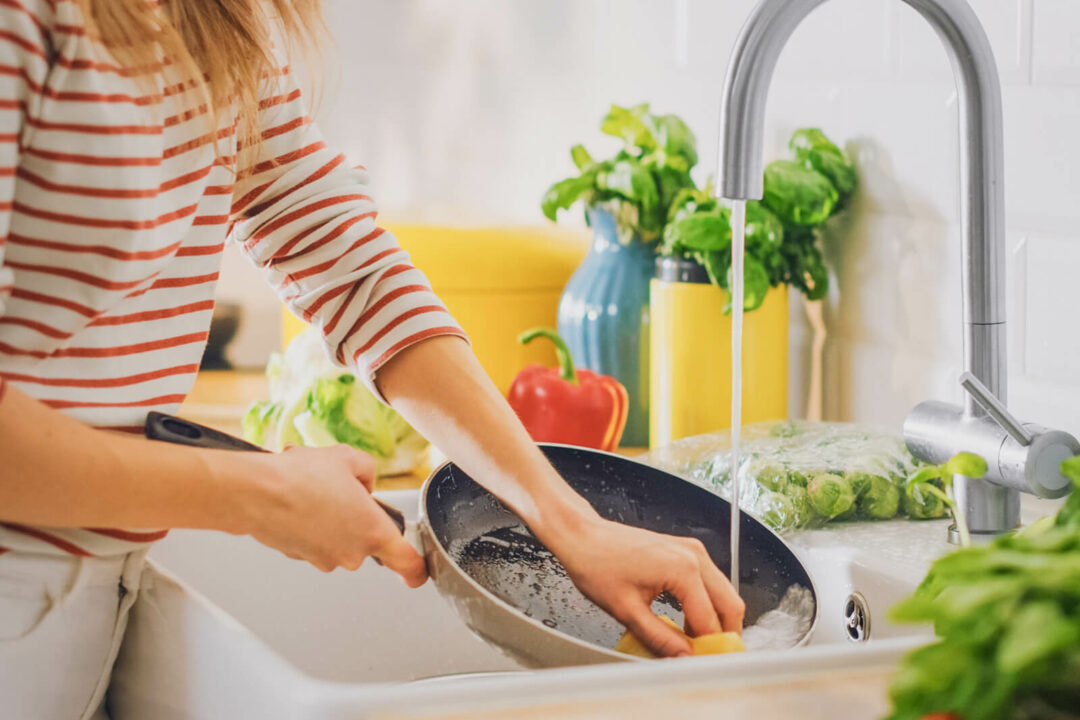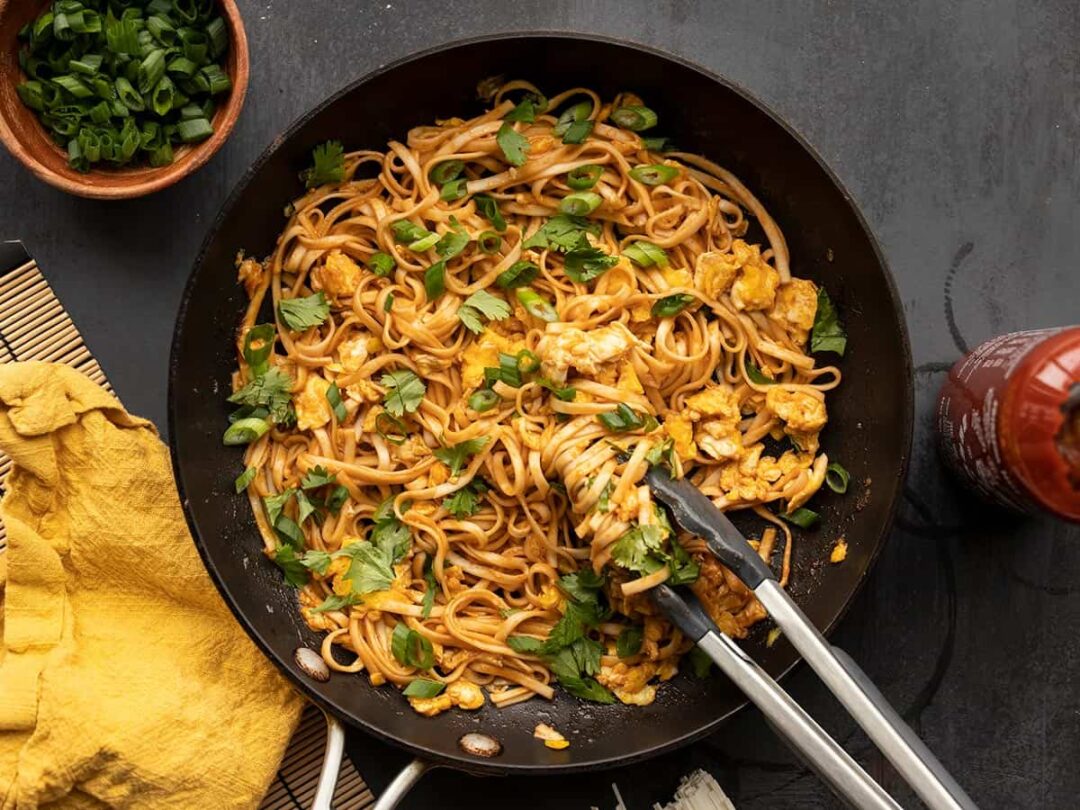What is the best way to clean non-stick pans? Yes, this is a question that many housewives ask and find the answer for themselves.
Non-stick pans for cooking are really a great thing, easy to use and produce the best quality of food as well as help you less hard in the cooking process. To clean non-stick pans, Apronese guides you through the steps below, the most complete and simple.
What is a Nonstick Surface
There are many uses for non-stick surfaces, as they have been engineered to reduce the ability of other materials to adhere to them.
Non-stick cookware is an example of how non-stick surfaces can be used, where food can brown without sticking to the pan, and non-stick cookware is often used to refer to surfaces that are coated with polytetrafluoroethylene (PTFE).
Clean Non-Stick Pans

Non-stick pan supports us a lot in daily cooking, from simple dishes to complex dishes, it is not exaggerated to say that it is a tool to help people save effort when cooking and dishes. also become more delicious and beautiful.
The following are some basic steps to follow when it comes to cleaning non-stick cooking utensils.
- Ensure the pan totally cools down before you wash it. After you have finished cooking in the pan, you should allow it to cool completely on the stovetop before washing it. If you soak a hot pan in cold water, the water could warp the pan and it could ruin the nonstick coating.
- In order to prolong the life of your pan, make sure you rinse it thoroughly with warm, soapy water and rinse it again with lukewarm water when the pan is cool. Use warm water instead of hot water to ensure your pan lasts a long time.
- With a sponge and dish soap, scrub the entire surface of the pan to remove all the remaining food residue. Apply dishwashing liquid directly to a sponge or washcloth and scrub the entire surface of the pan to ensure the food residue is completely removed. Rinse the pan well after scrubbing it.
- In order to prevent scratching the non-stick surfaces of the pans, use a clean, soft cloth to wipe them thoroughly after you have washed them. Set them on a vertical dish rack, or place paper towels between stacked pans to protect them from becoming scratched.
Ways to Clean Non-stick Pans
Washing and Drying Your Pan

1. Wash your pan by hand after every use
Despite the fact that the manufacturer may state that your pan is dishwasher-safe, never wash your pan in the dishwasher. Use a mild, soft soap, a soft cloth or sponge to clean your pan, and rinse it with lukewarm, not hot, water after cleaning.
- There are several types of cloths and sponges you can use to remove dirt and grime from your bathtub and other surfaces. For best results, you should use nylon or microfiber cloths.
- Hot temperatures and dishwashing detergent can reduce the life of your pans
- There is quite a bit of residue that can adhere to the pan surface when you wipe it with a towel rather than washing it, and this residue can cook and stain your pan during your next cooking session.
2. Soak the pan in warm, soapy water.
I would recommend that you soak the pan in warm, soapy water for ten to twenty minutes, and then hand wash it again to remove any remaining soap. Place the pan into a stopped-up sink.
- Add warm water to the sink, and then let the pan soak for ten to twenty minutes.
- Grease and residue are broken up with dish soap, which removes bacteria.
3. Scrub stubborn gunk with a baking soda paste, if needed
The best way to remove the baking soda from a pan is to use a non-metallic brush or sponge to make a paste with equal parts baking soda and water.
Dip the brush or sponge into the paste, and carefully dab it onto top and sides of the pan and allow the paste to sit for fifteen minutes. Rinse the pan thoroughly with water to remove the paste.
- Scrub your nonstick pans with nonstick soap, not steel wool or metallic sponges.
- Avoid rubbing or scrubbing the pan with baking soda because it is abrasive.
4. Heat oil and salt in the pan
As soon as the pan has cooled down, pour two tablespoons of vegetable-based oil into the pan. Heat the pan over medium heat. Add three tablespoons of salt to the pan. When the oil and salt are evenly distributed, lift the pan from the heat and shake the pan until it is evenly distributed. Once the pan has cooled, wash your hands thoroughly.
In the case that you do not have sea salt, use table salt.
5. Dry your pan immediately by hand.
In order to prevent rusting of your pan, make sure it is completely dry before you store it. Use paper towels or a soft dish towel to ensure that it is entirely dry. Do not store your pan when it is wet.

Using Your Nonstick Pan
1. Protect your pan from heat
In order to keep your nonstick pan from sticking to the pan, use a small amount of butter, oil, or fat before turning on the heat. Coating the pan evenly with butter, oil, or fat before using the pan won’t cause the pan to stick.
2. Don’t use non-stick cooking sprays on your pan
Instead of using non-stick cooking sprays, consider substituting oil, such as that from an oil mister, instead. Non-stick cooking sprays contain additives that form a buildup on nonstick cookware, resulting in uneven cooking of food.
3. Prevent metal and sharp objects from coming in contact with the pan
When you’re cooking with nonstick pans, it’s important to choose cooking utensils that won’t damage your pan. To prevent any damage to your pan, stay away from knives, metal utensils, and steel wool. Avoid cutting when the food is still in the pan, and don’t blend it with metal whisks.
Maintaining Your Nonstick Pan
1. Season your pan with oil
Your pan may come with instructions on how frequently, if at all, you should season it. After the pan has been rinsed and dried completely, rub a tablespoon of oil on the inside with a paper towel. Bake the pan for one hour at 300°F (149°C). Remove the oil with paper towels after it has cooled.
2. Temperature changes shouldn’t be sudden
Putting the pan in cold water while it’s hot is not a good idea, and vice versa. Allow your pan to cool naturally after it has been heated.
When sudden temperature changes take place, nonstick cookware can warp, resulting in uneven heat distribution in the future depending on how the heat is distributed.
3. Take care when storing your pan
In addition, you should store your pans in a way that allows for decent space in between. If you must stack them, you should do so so that they are not close to sharp corners or objects.
Make sure you put a paper towel between the pan and other cookware to avoid scratching it.

Although it is a good cooking aid for users, Apronese thinks that it must be cleaned and maintained properly for it to fulfill its mission. Don’t forget to share other ways to clean nonstick pans that you know for everyone’s reference.







